Tarantulas are fascinating creatures with diverse diets in the wild. However, when it comes to feeding them house spiders, including isopods, things might not be as straightforward as they seem. Understanding the feeding habits and nutritional needs of tarantulas is crucial for their well-being. Let’s dive deeper into the world of spider feeding habits and explore whether tarantulas will eat isopods.
Key Takeaways:
- Tarantulas have diverse diets in the wild, including insects, small arthropods, and occasionally small vertebrates.
- In captivity, a balanced and nourishing diet is essential for tarantulas, consisting of protein-rich insects and other feeder insects.
- House spiders, like isopods, are common in human dwellings but may not provide the necessary nutritional adequacy for pet tarantulas.
- Feeding house spiders to tarantulas can introduce potential risks such as the transfer of parasites and pathogens.
- Understanding tarantula feeding habits is crucial for responsible tarantula care and ensuring their health and vitality.
Will Tarantulas Eat Isopods
An Isopod is a type of crustacean commonly known as a pill bug or roly-poly. Tarantulas are carnivorous spiders that typically feed on insects and other small invertebrates. While tarantulas are known to primarily consume insects, they may also eat small crustaceans like isopods if given the opportunity. However, isopods are not a natural or common prey item for tarantulas, so they are more likely to feed on other types of invertebrates. do tarantulas eat isopods
Understanding Tarantula Diet and Feeding Habits
Tarantulas are fascinating creatures, known for their carnivorous nature and diverse diets in the wild. In their natural habitats, tarantulas feed on a wide range of prey, including insects, small arthropods, and occasionally small vertebrates. This diverse diet not only showcases their adaptability but also plays a crucial role in sustaining their arachnid prowess. However, when it comes to feeding them in captivity, it is important to provide a balanced and nourishing diet to ensure their well-being. will tarantulas eat isopods
The Importance of a Balanced Diet
When caring for pet tarantulas, a balanced diet is essential. This means offering protein-rich insects and other feeder insects that provide the necessary nutrients for their growth and development. Feeder insects such as crickets, roaches, and mealworms can be excellent food sources for tarantulas. These insects are readily available and provide the necessary protein, vitamins, and minerals that tarantulas need to thrive. tarantulas eating isopods
While feeding tarantulas house spiders, including isopods, may seem like a convenient and natural option, it is important to consider the nutritional adequacy of such prey. House spiders and isopods may not provide all the necessary nutrients that tarantulas require, potentially leading to nutritional deficiencies over time. Therefore, it is advisable to prioritize the use of feeder insects that are known to be nutritionally suitable for tarantulas.
| Feeder Insects | Nutritional Profile |
|---|---|
| Crickets | High in protein and calcium |
| Roaches | Rich in protein and essential fatty acids |
| Mealworms | Good source of protein and fat |
By offering a balanced diet that consists of these protein-rich feeder insects, tarantula owners can ensure that their pets receive the necessary nutrition for their overall health and vitality. Remember, providing a variety of feeder insects can also help stimulate the tarantula’s natural hunting instincts and provide mental and physical enrichment.
In conclusion, understanding tarantula diet and feeding habits is crucial for responsible pet care. While tarantulas may eat house spiders, including isopods, it is important to prioritize a balanced diet that consists of nutritionally suitable feeder insects. By providing the right nutrition, tarantula owners can ensure the well-being and longevity of these captivating arachnids. can tarantulas eat isopods
House Spiders: Species and Characteristics
House spiders, commonly found in human dwellings, exhibit unique species characteristics that contribute to their survival in various habitats. These smaller arachnids have efficient physiques, allowing them to navigate tight spaces with ease. Their camouflaging coloration enables them to blend seamlessly with their surroundings, making them less detectable to predators and prey alike. tarantula diet isopods
House spiders are known for their intricate web-spinning abilities. They construct elaborate webs to catch their prey, consisting of small insects and other arthropods. These intricate structures showcase the remarkable adaptability and resourcefulness of house spiders. tarantula and isopod interaction
While house spiders may be intriguing as a potential food source for tarantulas, it is important to consider their nutritional adequacy compared to alternative feeder insects. House spiders may not provide the same level of specific nutrients required to meet the dietary needs of pet tarantulas. Careful consideration must be given to ensure tarantulas receive a balanced diet to maintain their health and well-being. tarantula predation on isopods
House Spider Characteristics:
- Efficient physiques and camouflaging coloration
- Intricate web-spinning abilities
- Predation on small insects and arthropods
- Potential nutritional inadequacy for pet tarantulas
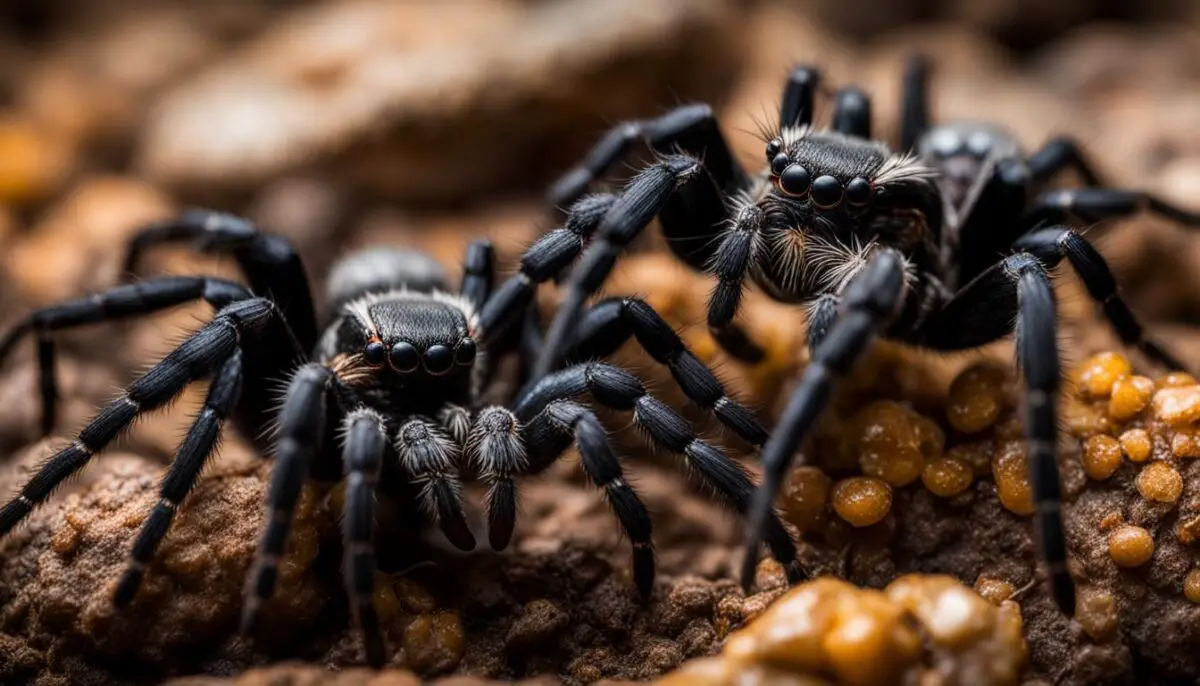
While house spiders are intriguing due to their interactions with tarantulas, such as potential predation on isopods, it is essential to prioritize the nutritional needs of these captivating arachnids. Offering appropriate feeder insects ensures the well-being and vitality of tarantulas, maintaining their captivating presence in captivity.
Potential Risks and Concerns
Feeding house spiders, including isopods, to tarantulas may seem like an interesting experiment. However, it is important to consider the potential risks and concerns associated with this practice. One of the main concerns is the transfer of parasites and pathogens from the house spiders to the tarantulas. House spiders can carry various microorganisms that may be harmful to tarantulas, leading to infections or diseases. This can pose a threat to the overall health and well-being of the tarantulas. tarantulas and isopods food source
Another concern is the difference in nutritional composition between house spiders, including isopods, and traditional feeder insects. Tarantulas have specific dietary requirements to meet their nutritional needs, and the nutritional content of house spiders may not be sufficient or appropriate for tarantulas. It is crucial to ensure that tarantulas receive a well-balanced diet that meets their nutritional requirements for growth, development, and overall health. tarantulas feeding on isopods.
While house spiders may seem like a natural food source for tarantulas, it is important to exercise caution and prioritize the health and well-being of these fascinating arachnids. Consulting with experts or experienced tarantula keepers can provide valuable insights and guidance on appropriate feeder insects and nutrition for tarantulas.
Potential Risks and Concerns:
- Transfer of parasites and pathogens from house spiders to tarantulas
- Differences in nutritional composition between house spiders and traditional feeder insects
By considering these potential risks and concerns, tarantula owners can ensure that they are providing the best possible care for their beloved pets. Instead of relying solely on house spiders, it is recommended to offer a variety of protein-rich feeder insects that are known to be safe and nutritionally beneficial for tarantulas. This will help to maintain the health and longevity of these captivating arachnids, allowing them to thrive in captivity.
| Feeder Insect | Nutritional Content | Safety for Tarantulas |
|---|---|---|
| Crickets | High in protein and minerals | Safe and commonly used |
| Mealworms | Rich in protein and fat | Safe when properly gut-loaded |
| Dubia Roaches | High in protein and low in fat | Safe and preferred by many keepers |
| Black Soldier Fly Larvae | Excellent calcium-phosphorus ratio | Safe and nutritionally balanced |
Choosing the right feeder insects and ensuring a well-rounded diet is crucial for the overall health and longevity of tarantulas. While the temptation to experiment with different prey items may arise, it is important to prioritize the safety and well-being of these fascinating creatures.
Spider Mating and Reproduction: An Intricate Dance
Spider mating rituals are a captivating display of nature’s complexity and diversity. Male spiders employ various strategies to attract and impress females, often showcasing visually stunning displays and intricate dances. These rituals serve an important purpose, as successful mating ensures the continuation of the spider species. However, the process is not without risks, particularly for the males.
Male spiders face the potential danger of being cannibalized by females during or after mating. This phenomenon, known as sexual cannibalism, occurs in many spider species and is believed to provide nutritional benefits to the female. In some cases, the male will offer a gift to the female as a means of appeasement, increasing his chances of survival.
“Spider mating rituals are a captivating display of nature’s complexity and diversity.”
Once mating is complete, female spiders store sperm in specialized organs called spermathecae, allowing them to fertilize eggs over an extended period. Female spiders then create silk egg sacs, carefully depositing their fertilized eggs inside. These silk sacs provide protection and support for the developing spiderlings, ensuring their survival until they are ready to venture out into the world.
Spider mating and reproduction are fascinating processes that reflect the intricacies of nature’s design. From elaborate courtship rituals to unique parental care behaviors, spiders offer us a glimpse into the remarkable adaptations that have allowed them to thrive for millions of years.
Spider Types and Global Distribution
Spiders are a diverse group of arachnids with a wide range of species and adaptations. From orb-weaver spiders with their intricate webs to the agility and speed of wolf spiders and the jumping capabilities of jumping spiders, each spider species has unique characteristics that allow them to thrive in various habitats. Understanding the different types of spiders and their global distribution provides valuable insights into their behaviors and survival strategies.
Here is an overview of some common spider types:
- Orb-Weaver Spiders: Known for their elaborate circular webs, orb-weaver spiders are skilled predators that use their webs to capture flying insects.
- Wolf Spiders: These spiders are known for their speed and hunting prowess. They do not rely on webs, but instead actively pursue their prey.
- Jumping Spiders: With excellent vision and impressive jumping abilities, these spiders are active hunters that pounce on their prey with remarkable precision.
- Black Widow Spiders: Black widow spiders are recognized for their venomous bite and distinctive red hourglass markings. They are typically found in dark, sheltered areas.
- Tarantulas: Tarantulas are large, hairy spiders known for their intimidating appearance. They can be found in various parts of the world and inhabit diverse ecosystems.
- Huntsman Spiders: Huntsman spiders are known for their large size and long legs. They are skilled hunters that rely on speed and stealth to capture their prey.
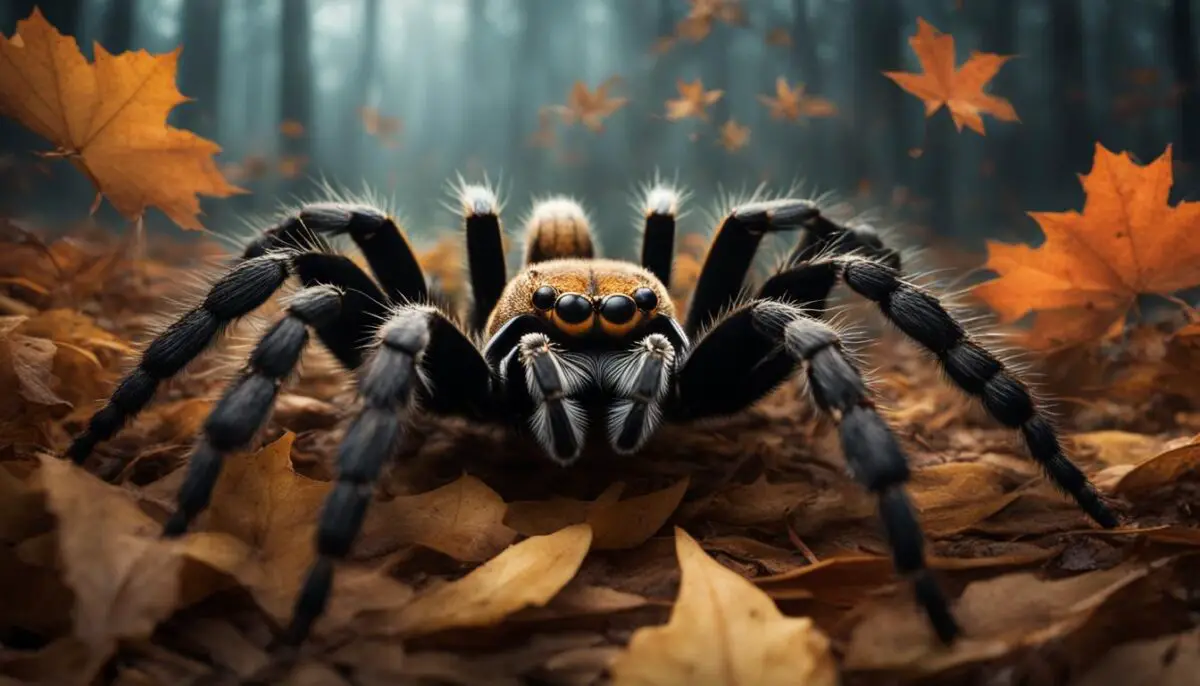
It is fascinating to see how spiders have adapted to different environments and developed unique characteristics to thrive in their respective habitats. Their global distribution showcases their ability to survive and thrive in a diverse range of ecosystems, from deserts to rainforests, and from underground burrows to treetops. By studying the types and distribution of spiders, researchers can gain a deeper understanding of their ecological roles and contributions to the balance of nature.
The Importance of Spiders in Ecosystems
Spiders are often misunderstood and feared creatures, but they play a crucial role in maintaining the balance of ecosystems. These fascinating arachnids are not only skilled predators but also provide numerous benefits to the environment.
One of the primary contributions of spiders is their ability to regulate pest populations. By preying on insects such as flies, mosquitoes, and crop-damaging pests, spiders help control their numbers and reduce the need for chemical pesticides. This natural form of pest control is not only environmentally friendly but also helps to preserve the health of plants and crops.
Spiders also contribute to nutrient cycling in ecosystems. When spiders capture and consume their prey, the nutrients from the insects are incorporated into their bodies. When spiders die, these nutrients are returned to the soil, enriching it and promoting healthier plant growth. This process of nutrient recycling helps to maintain the overall health and productivity of ecosystems.
| Benefit | Explanation |
|---|---|
| Pest Control | Spiders prey on insects, helping to regulate their populations and reduce the need for chemical pesticides. |
| Nutrient Cycling | Spiders contribute to the recycling of nutrients by capturing and consuming insects, returning the nutrients to the soil upon their death. |
| Food Source | Spiders serve as an important food source for other animals, including birds, reptiles, and small mammals. |
Additionally, spiders serve as a vital food source for other animals in the ecosystem. Birds, reptiles, and small mammals rely on spiders as a source of nutrition. By maintaining healthy spider populations, we ensure a stable food chain and support the survival of various species.
Overall, the presence of spiders in ecosystems is crucial for maintaining ecological balance. Their role as natural pest controllers, nutrient recyclers, and food sources highlights the significance of these often misunderstood creatures. It is essential to appreciate and protect spiders to preserve the health and diversity of our ecosystems.
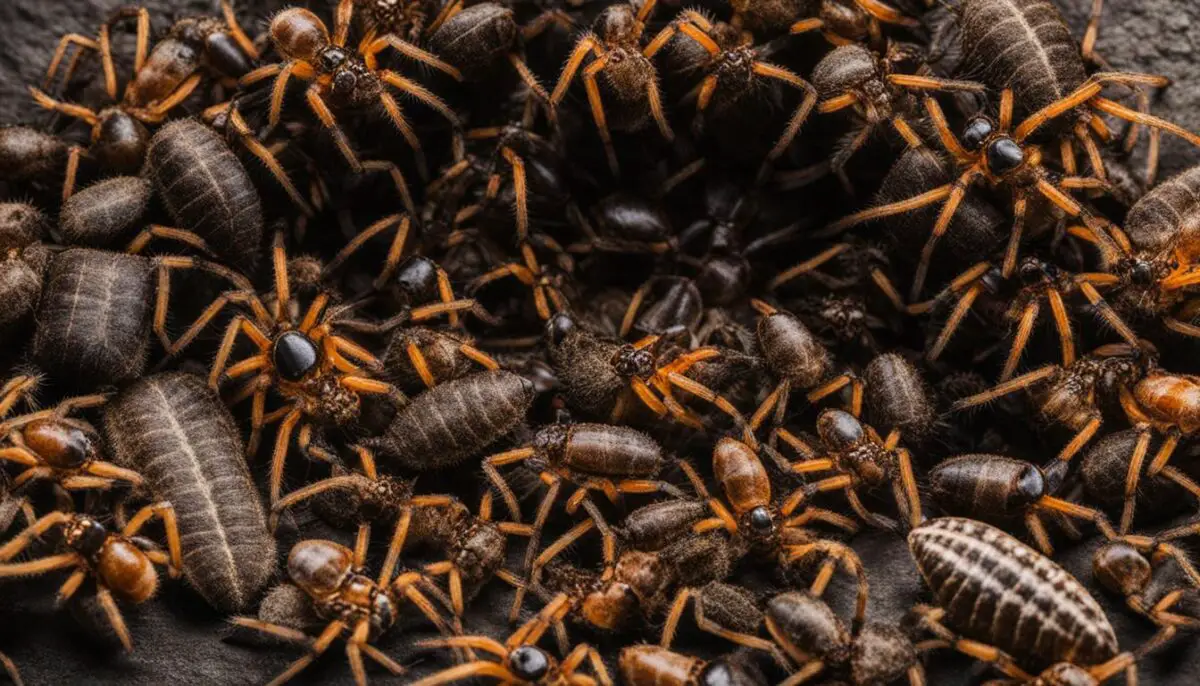
Spider Reproduction: From Mating to Offspring
Spider reproduction encompasses a fascinating journey from intricate mating rituals to the birth of spiderlings. Understanding this process sheds light on the remarkable adaptations that contribute to the survival of these arachnids. Mating rituals in spiders involve elaborate displays, dances, and gift-giving behaviors by males to attract and win over females. These displays not only showcase the male’s fitness but also play a crucial role in successful reproduction.
Male spiders use specialized appendages called pedipalps to transfer sperm to females during mating. This process can be perilous for males as they risk being cannibalized by the female. To increase the chances of reproductive success, males may offer gifts such as prey to distract the female and ensure successful mating.
After mating, females store the male’s sperm in specialized structures within their bodies. They then proceed to create silk egg sacs where they lay their eggs. These sacs provide protection and contribute to the survival of the developing spiderlings. Some spider species exhibit remarkable parental care behaviors, guarding the egg sacs and ensuring the well-being of their offspring until they hatch and disperse into the world.
Spider Parental Care: Ensuring Offspring Survival
Spider parental care varies across species, but it often involves safeguarding the eggs and providing nourishment for the spiderlings. Female spiders may exhibit behaviors such as creating silk coverings for the egg sacs, guarding them against predators, and even sacrificing their own lives to protect their offspring.
Once the spiderlings hatch, they disperse into the environment and start their independent lives. However, some spider species continue to provide care for their young even after hatching. This care can involve feeding, grooming, or offering protection until the spiderlings reach maturity.
| Spider Species | Parental Care Behavior |
|---|---|
| Wolf Spiders | Carry their egg sacs on their abdomen until the spiderlings hatch, providing protection and warmth. |
| Jumping Spiders | Construct silk retreats for their spiderlings, where they provide shelter, protection, and even regurgitate food for their young. |
| Trapdoor Spiders | Build underground burrows where they keep their egg sacs, guarding them until the spiderlings are mature enough to venture out. |
Spider reproduction showcases the intricate dance between males and females, highlighting the remarkable adaptations that contribute to their survival. From elaborate mating rituals to the birth of spiderlings, the reproductive journey of these arachnids is filled with awe-inspiring behaviors and parental care. Understanding spider reproduction provides a glimpse into the fascinating world of these remarkable creatures.
Spider Mating and Reproduction: Intriguing Facts
Spiders engage in fascinating mating rituals that showcase their complexity and diversity. Males employ various strategies to attract females, including visual displays, intricate dances, and even gift-giving behaviors. These mating rituals highlight the ingenuity and creativity of male spiders in their quest for successful reproduction.
One of the intriguing aspects of spider reproduction is the absence of traditional reproductive organs in male spiders. Instead, they use specialized appendages called pedipalps to transfer sperm to females during mating. This unique adaptation allows for more precise and efficient sperm delivery, increasing the chances of successful fertilization.
Female spiders, on the other hand, have the remarkable ability to store sperm for extended periods. They store the received sperm in special organs called spermathecae, which can keep the sperm viable for months or even years. This long-term sperm storage enables females to control their reproductive timing and maximize the chances of producing offspring.
Unique Parental Care Behaviors
Spider reproduction also involves fascinating parental care behaviors that vary across species. Some female spiders construct silk egg sacs to protect their developing eggs, while others carry their egg sacs with them or guard them until the spiderlings hatch.
One noteworthy example of parental care is observed in the wolf spider family (Lycosidae). Female wolf spiders carry their egg sacs attached to their spinnerets, allowing for better control of temperature and humidity. They actively protect the egg sacs from predators, ensuring the survival and well-being of their offspring.
These intriguing facts shed light on the intricacies of spider mating and reproduction. The unique adaptations and behaviors observed in spiders contribute to their reproductive success and highlight the remarkable diversity of strategies employed by these fascinating arachnids.
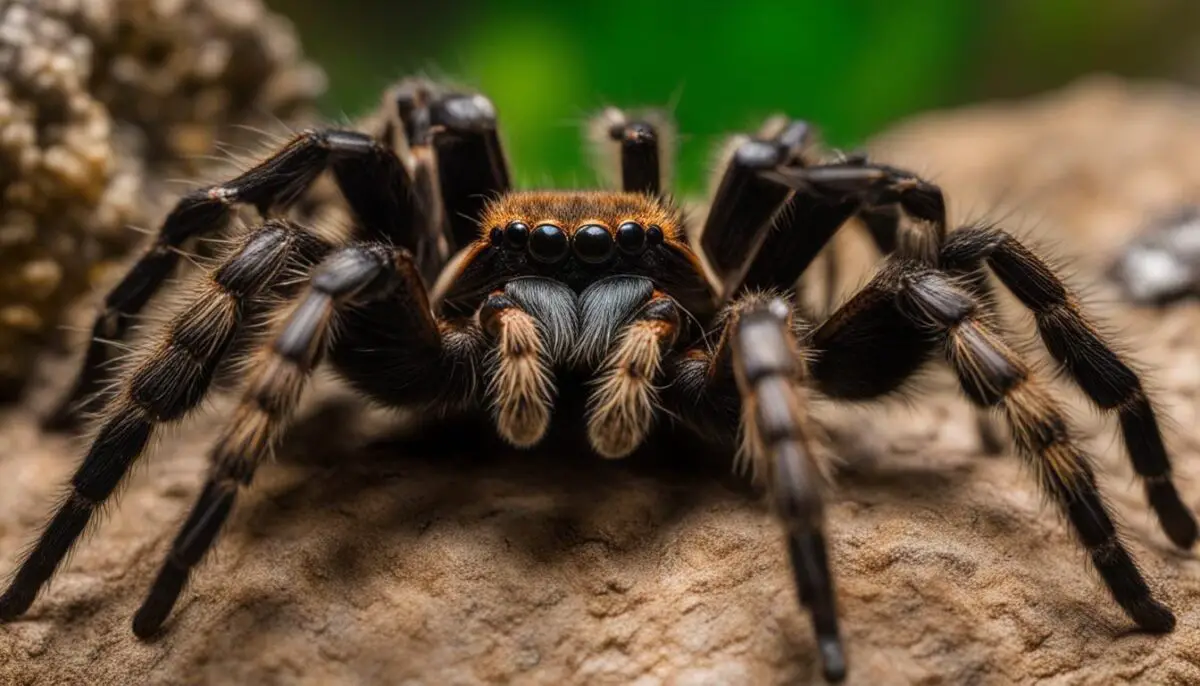
Spider Diversity and Adaptations
Spiders exhibit a remarkable range of diversity and adaptations that contribute to their survival in various habitats. From the intricate webs of orb-weaver spiders to the agility and speed of wolf spiders and the incredible jumping capabilities of jumping spiders, each species has unique characteristics that enable them to thrive.
One fascinating example is the orb-weaver spider, known for its elaborate and symmetrical webs. These intricate structures are not only used for capturing prey but also serve as a means of communication with potential mates and as a shelter. Orb-weaver spiders have developed specialized glands that produce different types of silk, allowing them to construct different parts of their webs with the appropriate strength and elasticity.
Another example is the jumping spider, a small but mighty predator. These spiders have excellent eyesight and are known for their ability to leap long distances to catch their prey. Their unique adaptations include the presence of four pairs of eyes, with the front pair being the most developed and providing them with excellent depth perception and visual acuity. These adaptations make jumping spiders formidable hunters.
| Spider Type | Main Characteristics |
|---|---|
| Orb-weaver spiders | Elaborate webs, specialized silk glands |
| Wolf spiders | Agility, speed, camouflage |
| Jumping spiders | Excellent eyesight, leaping abilities |
In addition to their physical adaptations, spiders also possess unique behaviors that aid in their survival. For example, many spiders rely on venomous bites to immobilize or kill their prey. They use their fangs and venom to inject toxins that paralyze or liquefy their meals, allowing for easier consumption. Other spiders, like wolf spiders, rely on their exceptional speed and camouflage to catch prey or avoid predators.
Understanding the diverse range of adaptations exhibited by spiders provides valuable insight into their behaviors and strategies for survival. Whether it’s the intricate webs of orb-weaver spiders or the incredible jumping capabilities of jumping spiders, each species has evolved distinct features and behaviors that allow them to thrive in their respective environments.

Spider Feeding Habits in Captivity
Feeding tarantulas in captivity requires careful consideration to ensure their health and well-being. While tarantulas are known for their diverse diets in the wild, providing a balanced diet is crucial for their nutritional needs. When it comes to feeding house spiders, including isopods, to tarantulas, it’s important to understand the potential risks and compare their nutritional profile to other feeder insects.
Tarantulas thrive on a varied diet consisting of protein-rich feeder insects. These insects provide the necessary nutrients for their growth, development, and overall vitality. While house spiders may be intriguing as a potential food source, their nutritional composition may differ from that of traditional feeder insects. Therefore, it’s essential to assess the nutritional adequacy and potential risks associated with feeding them to tarantulas.
To ensure the health and mental stimulation of tarantulas, offering a diverse range of feeder insects is recommended. This not only provides the necessary nutrients but also mimics their natural feeding habits in the wild. By offering a variety of insects, tarantulas can engage in natural hunting behaviors, promoting their overall well-being.
| Feeder Insects | Nutritional Composition | Benefits |
|---|---|---|
| Crickets | High in protein and essential nutrients | Easy to source and provide mental stimulation through hunting |
| Dubia Roaches | Rich in protein and low in chitin | Provide essential amino acids and promote healthy digestion |
| Mealworms | Good source of protein and healthy fats | Different texture and taste for sensory variety |
While house spiders, including isopods, may be suitable as an occasional addition to a tarantula’s diet, it’s essential to prioritize the use of traditional feeder insects to meet their nutritional needs effectively. By offering a balanced and varied diet, tarantula owners can ensure the overall health and vitality of their captivating arachnids.
Conclusion
Understanding the feeding habits of tarantulas and providing them with a balanced diet is crucial for their well-being. While tarantulas are known for their diverse diets in the wild, the question of whether they will eat isopods, a type of house spider, is not straightforward.
Feeding tarantulas house spiders, including isopods, may introduce potential risks such as the transfer of parasites and pathogens. Additionally, the nutritional composition of house spiders may not meet the dietary needs of pet tarantulas, which require a protein-rich diet.
It is important to prioritize the health and nutritional needs of tarantulas by offering appropriate feeder insects. While the interaction between tarantulas and isopods is intriguing, it is essential to consider alternative feeder insects that provide the necessary nutrients for these captivating arachnids.
FAQ
Will tarantulas eat isopods?
While tarantulas are known for their diverse diets, feeding them isopods, including house spiders, may not be as straightforward as it seems. It is important to consider their nutritional adequacy compared to other feeder insects.
Do tarantulas eat isopods?
Tarantulas have a carnivorous inclination and prey on insects, small arthropods, and occasionally small vertebrates in the wild. However, the nutritional composition and potential risks of feeding them isopods should be taken into consideration for their well-being in captivity.
Can tarantulas eat isopods?
Feeding house spiders, including isopods, to tarantulas introduces potential risks such as the transfer of parasites and pathogens. The nutritional adequacy of house spiders compared to alternative feeder insects is also a concern for meeting the dietary needs of pet tarantulas.
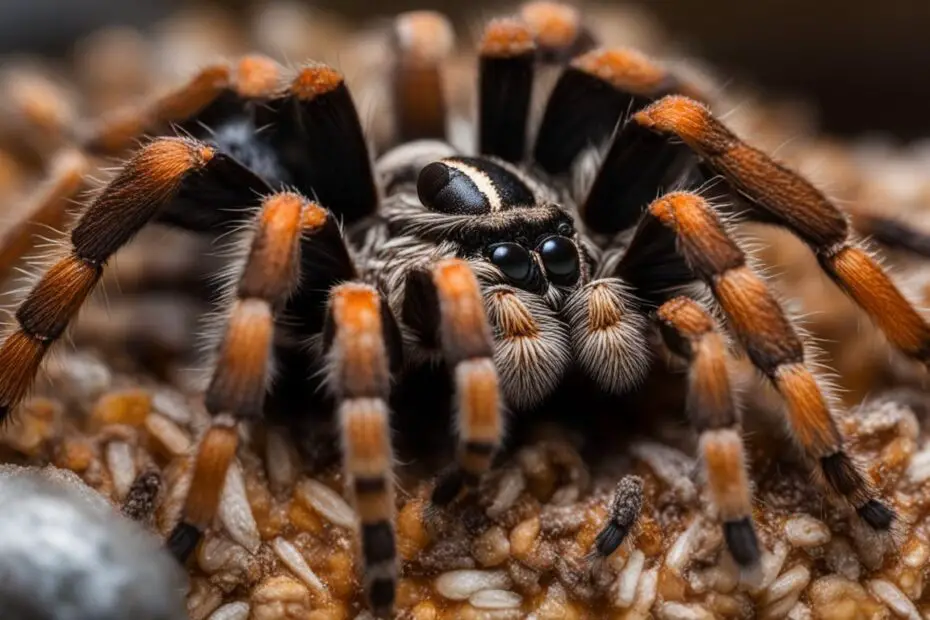
Loving your blog and your content. Keep up the good work and please keep the content coming.